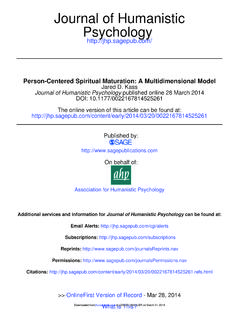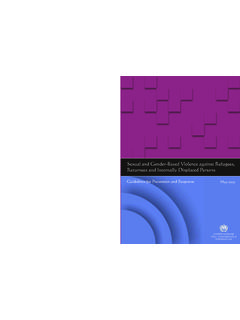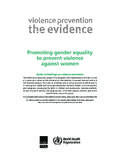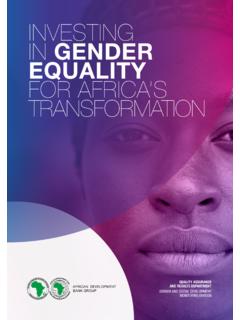Transcription of Promoting Resilience through Yoga - Scattergood Foundation
1 Promoting Resilience through yoga CASE Resilience through yoga :Pro"ling the Implementation of Trauma-Informed Integrative Mindfulness Programming in Post-Earthquake Haiti%BOJFMMF 3 PVTTFBV 1I% -.)$"TTJTUBOU 1 SPGFTTPS #PTUPO 6 OJWFSTJUZ #PTUPO ." | EBOSPV!CV FEV&MJ[BCFUI +BDLTPO .1) 1 SPHSBN .BOBHFS )BSWBSE 4 DIPPM PG 1 VCMJD )FBMUI #PTUPO ." | FMJ[BCFUI L KBDLTPO!HNBJM DPN5IF DVSSFOU XPSL QSFTFOUT B QSFMJNJOBSZ DBTF SFQPSU FYQMPSJOH UIF USBOTMBUJPO BEBQUBUJPO BOE JNQMF NFOUBUJPO PG B USBVNB JOGPSNFE JOUFHSBUJWF NJOEGVMOFTT QSPHSBN 5*.]]
2 #P UISPVHI B USBJO UIF USBJOFS NPEFM BT EFWFMPQFE UP BEESFTT UIF F FDUT PG HFOEFS CBTFE WJPMFODF BOE USBVNBUJD TUSFTT JO QPTU FBSUIRVBLF )BJUJ 5IF EFWFMPQNFOU BOE JNQMFNFOUBUJPO PG UIJT ZPHB CBTFE QSPHSBN JT FYBNJOFE EFNPOTUSBUJOH JNQMJDBUJPOT GPS RVBMJUZ TFSWJDF QSPWJTJPO XJUI VOEFSTFSWFE QPQVMBUJPOT 5IF QSPHSBN UBSHFUT UIF NJUJHBUJPO PG USBVNBUJD TZNQUPNPMPHZ BT XFMM BT QSFWFOUBUJWF TUSBUFHJFT BEESFTTJOH UIF JOUFSHFOFSBUJPOBM DZDMF PG USBVNB BOE WJPMFODF *OJUJBM BOFDEPUBM BOE PCTFSWBUJPOBM PVUDPNFT BSF QSF TFOUFE FYQMPSJOH UIF QSPDFTT UP EBUF JO USBOTMBUJOH UIJT ZPHB CBTFE DVSSJDVMVN GPS XPNFO JO 1 PSU BV 1 SJODF )
3 BJUJ 'JOEJOHT TVHHFTU UIBU QBSUJDJQBUJPO JO UIF 5*.#P QSPHSBNNJOH NBZ BNFMJPSBUF UIF JNQBDU PG USBVNBUJD TUSFTT BOE FODPVSBHF BMUFSOBUJWF TUSBUFHJFT GPS FNPUJPO SFHVMBUJPO The current work presents a case report exploring the translation, adaptation, and implementation of TIMBo, a trauma-informed integrative mindfulness program, through a train-the-trainer model, as developed to address the e"ects of gender-based violence and traumatic stress. Here we pro!le an integrated mindfulness program in its initial implementation in Port-au-Prince, Haiti.
4 This work examines yogaHOPE s Trauma-in-formed Mind Body (TIMBo) program as carried out in partnership with local Haitian organiza-tion Ananda Marga Universal Relief Team (AMURT-Haiti). Background on both organizations is provided and the initial implementation process is detailed. In this paper, we discuss initial promising outcomes and challenges in translating this yoga -based curriculum for Haitian participants. We describe initial processes as well as goals for future program development and implementation based on what has been learned to date.
5 Although this work represents a preliminary preview of a cross-national translation of yoga -based programming, we are hopeful that later outcome measures will demonstrate the bene!t of programming. In pro!l-ing the successes as well as challenges to date, we hope to encourage culturally competent CASE REPORT 39 Danielle Rouseau, PhD, LMHC, Elizabeth Jackson, MPHCASE that recognize the bene!ts of yoga and mindfulness in addressing the impact of traumatic stress as well as to foster continued work in this presenting this preliminary case report, we pro-vide contextual background information on Haiti, in-troduce the agencies involved, and pro!
6 Le the TIMBo program itself. We then discuss implementation, moni-toring, and evaluation to date, including an examination of challenges and successes. Finally, we outline the next steps in the evaluation of this yoga -based program in Port-au-Prince, January 12, 2010, Haiti experienced a major earth-quake that left signi!cant devastation in its wake. As a result of damage to the city, many were forced to relo-cate to tent communities throughout the capital city of Port-au-Prince. Reports indicate 230,000 people were killed and over 300,000 injured with nearly two million left homeless.
7 Both prior to, and in the wake of the earth-quake, Haitian women have faced multiple and complex traumas. Many face concerns common to women in the United States, including poverty and distinct physical and mental health issues. Further, without the infrastruc-ture for sustained management of the impact of local weather systems, Haitians have endured multiple devas-tating natural disasters. As a result of the 2010 earthquake, many women faced displacement, loss of loved ones, and physical and emotional trauma.
8 In addition, these women face ongoing gender-based sexual and physical violence oc-curring in the temporary housing areas (tent cities) that have arisen throughout Port-au-Prince and beyond. As Paul Farmer has stated, These challenges housing, water, and sanitation, but also gender based violence were questions of recovery and reconstruction, not res-cue and relief (Farmer, 2011, p. 87).Even prior to the earthquake, intimate-partner and sexual violence toward women were present, but re-sources for women were inadequate.
9 In addition, many of the limited resources that did exist were destroyed in the earthquake. According to Amnesty Internation-al, Sexual and other forms of gender-based violence were widespread in Haiti before 12 January 2010, but the earthquake shattered what few protection mecha-nisms did exist (Amnesty International, 2011, p. 6). For example, the local branch of International Planned Par-enthood Federation, PROFAMIL, lost two primary clin-ics during the earthquake. Further, the vulnerability of women and girls was often neglected during the initial crisis response to the earthquake (Claeys, 2010).
10 Due to conditions of poverty and lack of organized resources, women and girls in Haiti frequently face precarious health situations and lack provision for basic gender-based needs(Claeys, 2010). There exists a need to ad-dress gender-related norms and structural factors that have placed Haitian women at risk for intimate-partner and sexual-based violence (Gage & Hutchinson, 2006).Ultimately, the speci!c needs of women who have su"ered trauma often go unrecognized and, therefore, are inadequately addressed.







